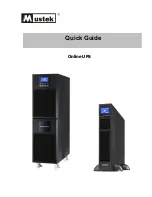
SAVE THESE INSTRUCTION-This manual contains important instructions that should be
followed during installation and maintenance of the UPS and batteries.
Do not connect appliances or devices which would overload the UPS system (e.g. laser printers)
to the UPS output sockets.
Place cables in such a way that no one can step on or trip over them.
Do not connect domestic appliances such as hair dryers to UPS output sockets.
The UPS can be operated by any individuals with no previous experience.
Connect the UPS system only to an earthed shockproof outlet which must be easily accessible
and close to the UPS system.
Please use only VDE-tested, CE-marked mains cable (e.g. the mains cable of your computer)
to connect the UPS system to the building wiring outlet (shockproof outlet).
Please use only VDE-tested, CE-marked power cables to connect the loads to the UPS system.
When installing the equipment, it should ensure that the sum of the leakage current of the UPS
and the connected devices does not exceed 3.5mA.
Do not disconnect the mains cable on the UPS system or the building wiring outlet (shockproof
socket outlet) during operations since this would cancel the protective earthing of the UPS
system and of all connected loads.
The UPS system features its own, internal current source (batteries). The UPS output sockets
or output terminals block may be electrically live even if the UPS system is not connected to the
building wiring outlet.
In order to fully disconnect the UPS system, first press the OFF/Enter button to disconnect the
mains.
Prevent no fluids or other foreign objects from inside of the UPS system.
The UPS system operates with hazardous voltages. Repairs may be carried out only by
qualified maintenance personnel.
Caution - risk of electric shock. Even after the unit is disconnected from the mains (building
wiring outlet), components inside the UPS system are still connected to the battery and
electrically live and dangerous.
Before carrying out any kind of service and/or maintenance, disconnect the batteries and verify
that no current is present and no hazardous voltage exists in the terminals of high capability
capacitor such as BUS-capacitors.
Only persons are adequately familiar with batteries and with the required precautionary
measures may replace batteries and supervise operations. Unauthorized persons must be kept
well away from the batteries.
Caution - risk of electric shock. The battery circuit is not isolated from the input voltage.
Hazardous voltages may occur between the battery terminals and the ground. Before touching,
please verify that no voltage is present!
Batteries may cause electric shock and have a high short-circuit current. Please take the
precautionary measures specified below and any other measures necessary when working with
batteries:
-
remove wrist watches, rings and other metal objects
-
use only tools with insulated grips and handles.
When changing batteries, install the same number and same type of batteries.
Do not attempt to dispose of batteries by burning them. This could cause battery explosion.
Do not open or destroy batteries. Escaping electrolyte can cause injury to the skin and eyes. It
may be toxic.
Please replace the fuse only with the same type and amperage in order to avoid fire hazards.
Do not dismantle the UPS system.
For Rack Tower Model
Tower
S
T
E
P
1
S
T
E
P
2
S
T
E
P
3
Rack
Attach mounting ears to the side mounting holes of
UPS using the screws provided and the ears should
face forward.
Lift the UPS module and slide it into rack enclosure. Attach the
UPS module to the rack with screws, nuts and washers
(user-provided) through its mounting ears and into the rack rails.
Button
Function
ON/Enter Button
Turn on the UPS: Press and hold the button more than 0.5s to turn on the UPS.
Enter Key: Press this button to confirm the selection in setting menu.
OFF/ESC Button
Turn off the UPS: Press and hold the button more than 0.5s to turn off the UPS.
Esc key: Press this button to return to last menu in setting menu.
Test/Up Button
Battery test: Press and hold the button more than 0.5s to test the battery while in AC mode, or CVCF mode.
UP key: Press this button to display next selection in setting menu.
Mute/Down Button
Mute the alarm: Press and hold the button more than 0.5s to mute the buzzer. Please refer to section 3-4-9 for
details.
Down key: Press this button to display previous selection in setting menu.
Test/Up + Mute/Down Button
Press and hold the two buttons simultaneous more than 1s to enter/escape the setting menu.
1)
Share current port (only available for parallel model)
2)
Parallel port (only available for parallel model)
3)
External battery connector
4)
Intelligent slot
5)
RS-232 communication port
6)
USB communication port
7)
Emergency power off function connector (EPO connector)
8)
Input circuit breaker
9)
Output terminals
10)
Ground
11)
Input terminals
12)
Cooling Fan
13)
External maintenance bypass switch port
14)
Battery pack output circuit breaker
15)
Maintenance bypass switch
PM 6000/10000 LCD Online IEC
V e r s i o n : 1 . 0
EN










































